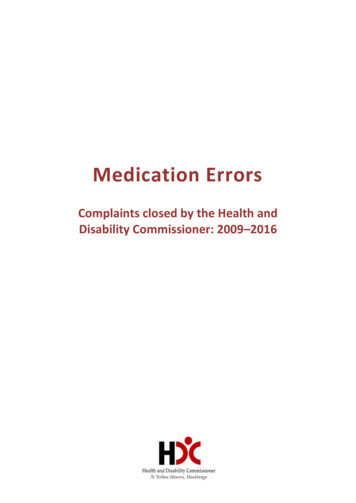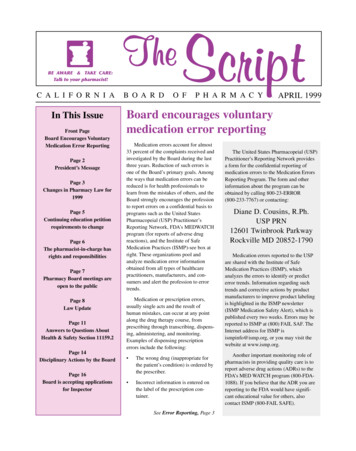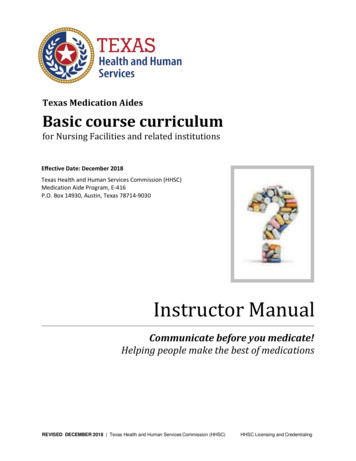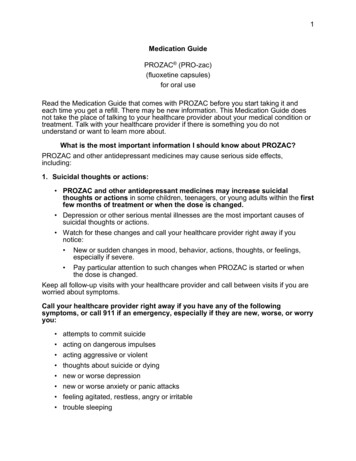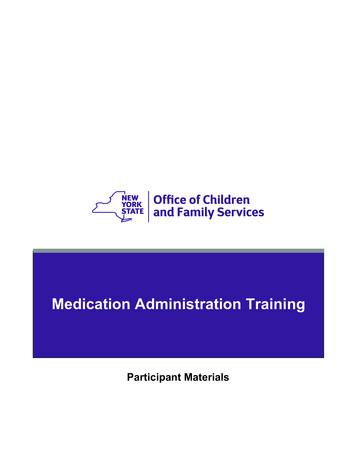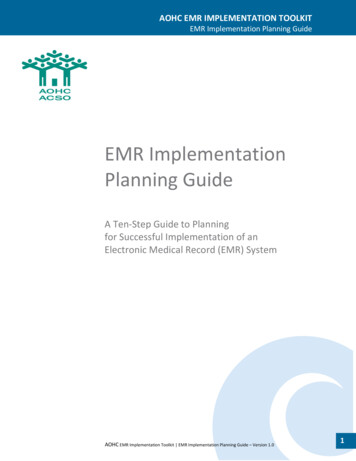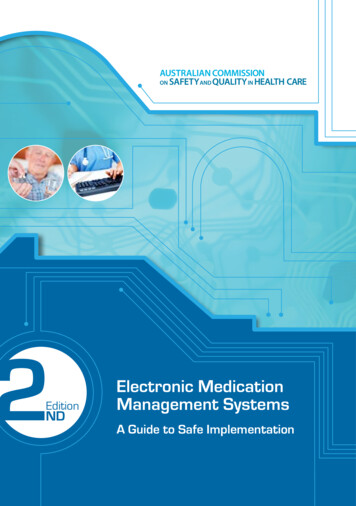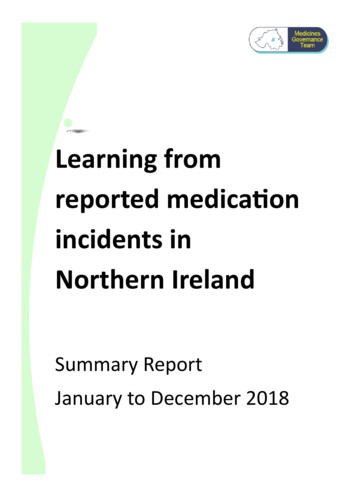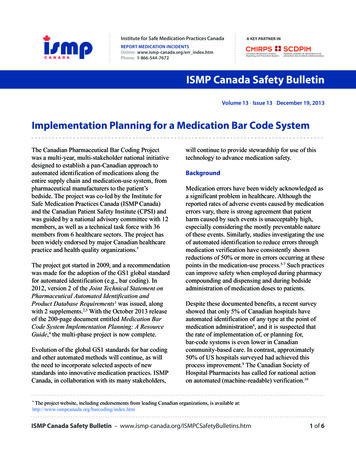
Transcription
Institute for Safe Medication Practices CanadaA KEY PARTNER INREPORT MEDICATION INCIDENTSOnline: www.ismp-canada.org/err index.htmPhone: 1-866-544-7672Volume 13 Issue 13 December 19, 2013Implementation Planning for a Medication Bar Code SystemThe Canadian Pharmaceutical Bar Coding Projectwas a multi-year, multi-stakeholder national initiativedesigned to establish a pan-Canadian approach toautomated identification of medications along theentire supply chain and medication-use system, frompharmaceutical manufacturers to the patient’sbedside. The project was co-led by the Institute forSafe Medication Practices Canada (ISMP Canada)and the Canadian Patient Safety Institute (CPSI) andwas guided by a national advisory committee with 12members, as well as a technical task force with 36members from 6 healthcare sectors. The project hasbeen widely endorsed by major Canadian healthcarepractice and health quality organizations.*The project got started in 2009, and a recommendationwas made for the adoption of the GS1 global standardfor automated identification (e.g., bar coding). In2012, version 2 of the Joint Technical Statement onPharmaceutical Automated Identification andProduct Database Requirements1 was issued, alongwith 2 supplements.2,3 With the October 2013 releaseof the 200-page document entitled Medication BarCode System Implementation Planning: A ResourceGuide,4 the multi-phase project is now complete.Evolution of the global GS1 standards for bar codingand other automated methods will continue, as willthe need to incorporate selected aspects of newstandards into innovative medication practices. ISMPCanada, in collaboration with its many stakeholders,will continue to provide stewardship for use of thistechnology to advance medication safety.BackgroundMedication errors have been widely acknowledged asa significant problem in healthcare. Although thereported rates of adverse events caused by medicationerrors vary, there is strong agreement that patientharm caused by such events is unacceptably high,especially considering the mostly preventable natureof these events. Similarly, studies investigating the useof automated identification to reduce errors throughmedication verification have consistently shownreductions of 50% or more in errors occurring at thesepoints in the medication-use process.5-7 Such practicescan improve safety when employed during pharmacycompounding and dispensing and during bedsideadministration of medication doses to patients.Despite these documented benefits, a recent surveyshowed that only 5% of Canadian hospitals haveautomated identification of any type at the point ofmedication administration8, and it is suspected thatthe rate of implementation of, or planning for,bar-code systems is even lower in Canadiancommunity-based care. In contrast, approximately50% of US hospitals surveyed had achieved thisprocess improvement.9 The Canadian Society ofHospital Pharmacists has called for national actionon automated (machine-readable) verification.10The project website, including endorsements from leading Canadian organizations, is available SMP Canada Safety Bulletin – www.ismp-canada.org/ISMPCSafetyBulletins.htm1 of 6
Medication Bar Code System Implementation Planning: A Resource GuideThe resource guide for implementationIn order for bar coding to improveplanning is designed for practice andpatient safety, nurses and otherexecutive leaders, as well ashealthcare providers also need apractitioners, in both communityclear understanding of how thebased (e.g., long-term care homes)technology works and how to useand institutional care (e.g., hospitals)it to support their practice.settings. It was reviewed by moreBarb Mildon, Presidentthan 20 leading practice experts fromCanadian Nurses Associationvarious disciplines and practicesettings. The resource guide provides detailed reviews of both acquisitionand implementation strategies for bar code-assisted medication systems.The document begins with a synopsis of recommendations and findings.This synopsis is followed by three detailed sections describing the strategicdiscussions that are needed for implementation, as outlined below.A Bar Code PrimerThe “primer” section explains, in simplified terms, how bar coding achieves verification of patients, medications,and services, including how additional data are obtained and documented in an improved manner during theverification process. Figure 1 shows a simplified automated identification and data capture system for bar codemedication administration. Figure 2 shows various forms of bar codes (symbologies), indicating how certain barcode types may be better than others for specified medication (or other) practices.Figure 1: Flow diagram of information verification with bar code medication administrationRead the ProductData CarrierData TIN)Verification Process and WarningsCorrect MedicationCorrect DoseCorrect PatientCorrect Date/TimeAdminister DoseSoftwareFinds theCode in aDatabaseSoftwareChecks Date of MftOtherSoftwareExtracts theCodeInformationSoftwareDocumentsEventISMP Canada Safety Bulletin – Volume 13 Issue 13 December 19, 20132 of 6
Figure 2: Different forms of bar code symbologyBAR CODE SYMBOLOGYSUMMARIZED FEATURESUPC A (GTIN 12) One-dimensional Omnidirectional 12 Character (others exist for 8 and 13 character versions also) Numeric characters Only Allows GTIN-12 (12 character GTINs only) Point of SaleGS1 DataBar (GTIN 14) One-dimensional Omnidirectional 14 Character (GTIN 12 or 13 character versions are also allowed, if the GTIN numberis padded with zeroes (0) on the left to make up the full 14 character string) Numeric characters Only Allows GS1 Application Identifiers (GTIN and others)GS1 DataBar Expanded One-dimensional 74 Numeric or 41 alphanumeric Omnidirectional Allows GS1 Application Identifiers (GTIN and others)GS1- DataBar Composite Mixed one-dimensional and two-dimensional Allows GS1 Application Identifiers (GTIN and others)GS1 Data Matrix Two-dimensional, compact 3116 Numeric or 2335 alphanumeric Can be etched on metal Allows GS1 Application Identifiers (GTIN and others) Camera-based readers requiredGS1 QR Codes Approved for product or customer information (e.g., information websites) Not approved yet for use in product automated identification.Building the Strategic Case for Automated Identification of MedicationsThe second detailed section explains the primary and secondary impacts of medication bar coding, includingreductions in medication errors and patient harm, avoidance of secondary and tertiary effects of errors, and declinein wasted healthcare expenditures related to such errors, from both local and system-wide perspectives. Thesection also includes a discussion of high-reliability organizations which adhere to principles for “designing out”failure and achieving heightened quality. These principles are reviewed and the bar coding process is compared, toshow how implementation of bar coding can align with achieving high-reliability organizations within healthcare.The section concludes by reviewing recommendations from other leading organizations and reporting fiveCanadian success stories.Implementation ConsiderationsLack of attention to detail in acquisition, testing, and implementation planning often results in failure of systemreform, which in turn leads to frustration among healthcare providers, withdrawal of involvement, and lack ofcommitment. This failure will result in diminished compliance by users and implementation of hiddenwork-arounds, ultimately reducing practice consistency and quality on all fronts.ISMP Canada Safety Bulletin – Volume 13 Issue 13 December 19, 20133 of 6
Figure 3: Considerations for implementation of new technologyThe Foundationfor Safety Culture ChangeImplementation FailureImplementation Process MapFacing External FactorsSystem Failure ModesLevel I: Technical KnowledgeInternal High Reliability ConsiderationsReducing Failure RisksLevel II: Strategic PlanConclusionLevel III: Planning ImplementationThis section also reviews external and internal (cultural) influences on technology implementation. Knownimplementation failure points are identified, and recommendations are made for improving acquisition planningthrough requests for proposals, software functionality checklists, and progressive usability testing of the system indifferent clinical and urgency situations. Involvement of healthcare providers as equal partners in development ofthe system is of paramount importance. Pre-implementation sessions with staff are needed, both to develop aculture of safety and to emphasize partnership. These sessions should be followed by staged training strategies.During and after implementation, a progressive “go-live” approach and survey process are recommended.ConclusionWorking together is key to reducing the potential for medication errors. Common standards andsharing of best practices can enable more effective use of technology in patient care environmentsso as to help Canadians and their healthcare providers to achieve safer medication practices.Richard Alvarez, President and CE0Canada Health InfowayTwo previous bulletins outlined the development of the national pharmaceutical bar coding project and therecommendations for pharmaceutical bar coding that have been made as a result of this collaborative effort.11,12For health system innovation to take root, practitioners’ voices must be heard. You and your organization canhelp to spread the word about the need for system reform by using the resource guide and undertaking thefollowing activities: Contact your professional practice organization, ISMP Canada, or CPSI and add your endorsement. Discuss medication bar coding processes with your facility’s practice leaders. Meet with your organization’s senior executives, including the CFO and CIO, to ensure they areaware of the benefits and values of automated identification strategies. Start discussing implementation issues, such as required system functionality and usability testing,and engage your information system provider(s).ISMP Canada Safety Bulletin – Volume 13 Issue 13 December 19, 20134 of 6
Medication Bar CodingReduces Serious ErrorsMedication bar coding practices significantly reduceserious errors and patient harm, while improving boththe patient care environment and electronic health recorddocumentation. Find out more about the movement towardimproved care and access the 200-page Medication BarCode Implementation Planning Resource Guide and otherimportant information.Canadian PharmaceuticalBar Coding ProjectJoint Technical Statement(Version II)ismp-canada.org/barcodingonPharmaceutical Automated Identificationand Product Database RequirementsInput and technical support provided by:February 24, 2012(This version replaces Version I, dated January 15, 2010)AcknowledgementsMembers of the National Implementation Advisory Committee, representing the following organizations, are acknowledgedfor their contributions: Canada Health Infoway, Canada’s Research-Based Pharmaceutical Companies, Canadian Associationfor Pharmacy Distribution Management, Canadian Association of Chain Drug Stores, Canadian Generic PharmaceuticalAssociation, Canadian Nurses Association, Canadian Society of Hospital Pharmacists, GS1 Canada, Health Canada (observerstatus), liaison for Canadian group purchasing organizations (Medbuy Corporation, HealthPRO, and ApprovisionnementMontréal), and the Public Health Agency of Canada.ISMP Canada and the Canadian Patient Safety Institute gratefully acknowledge the following organizations for their supportof the Canadian Pharmaceutical Bar Coding Project: Medbuy Corporation, HealthPRO Procurement Services Inc., BaxterCorporation, Healthcare Insurance Reciprocal of Canada (HIROC), Pharmaceutical Partners of Canada Inc. (PPC),AstraZeneca Canada Inc., Eli Lilly Canada Inc., Healthmark Services, McKesson Canada, Pfizer Canada Inc., SandozCanada Inc., Sanofi Canada Inc., TEVA Novopharm Ltd., Canadian Patient Safety Institute.References1. Canadian Pharmaceutical Bar Coding Project. Joint technical statement (version II) on pharmaceutical automated identification andproduct database requirements. Toronto (ON): Institute for Safe Medication Practices Canada; 2012 [cited 2012 Nov 28]. Available /JTSv2/JTSv2.pdf2. Canadian Pharmaceutical Bar Coding Project: Joint technical statement on pharmaceutical automated identification and product databaserequirements (version II). Supplement A: Guidance for placement of bar codes on pharmaceutical labels for primary packaging. Toronto(ON): Institute for Safe Medication Practices Canada; 2012 [cited 2012 Nov 28]. Available /JTSv2/SupplA-LabellingGuidelines.pdf3. Canadian Pharmaceutical Bar Coding Project: Joint technical statement on pharmaceutical automated identification and product databaserequirements (version II). Supplement B: Minimum software safety functionality checklist. Toronto (ON): Institute for Safe MedicationPractices Canada; 2012 [cited 2012 Nov 28]. Available /JTSv2/SupplB-MinFunctionality.pdfISMP Canada Safety Bulletin – Volume 13 Issue 13 December 19, 20135 of 6
4. Canadian Pharmaceutical Bar Coding Project. Medication bar code system implementation planning: a resource guide. Toronto (ON):Institute for Safe Medication Practices Canada; 2013 [cited 2013 Dec 12]. Available /ResourceGuide/BarCodingResourceGuideFINAL.pdf5. Poon EG, Keohane CA, Yoon CS, Ditmore M, Bane A, Levtzion-Korach O, et al. Effect of bar-code technology on the safety ofmedication administration. N Engl J Med. 2010;362(18):1698-1707.6. Poon EG, Cina JL, Churchill W, Patel N, Featherstone E, Rothschild JM, et al. Medication dispensing errors and potential adverse drugevents before and after implementing bar code technology in the pharmacy. Ann Intern Med. 2006;145(6):426-434.7. Paoletti RD, Suess TM, Lesko MG, Feroli AA, Kennel JA, Mahler JM, et al. Using bar-code technology and medication observationmethodology for safer medication administration. Am J Health Syst Pharm. 2007;64(5):536-543.8. Babich M, Bornstein C, Bussières JF, Hall K, Harding J, Lefebvre P, et al., editors. Hospital pharmacy in Canada 2009/2010 report. EliLilly Canada; 2010 [cited 2013 Dec 12]. Available t/rep 2010 toc.asp9. Pederson CA, Schneider PJ, Scheckelhoff DJ. ASHP national survey of pharmacy practice in hospital settings: dispensing andadministration – 2011. Am J Health Syst Pharm. 2012;69(9):768-785.10. CSHP 2015 status: goals and objectives (May 2011). Ottawa (ON): Canadian Society of Hospital Pharmacists; 2011 [cited 2012 Jul30]. Available P2015GoalsandObjectivesStatusReportMay2011.pdf11. Pharmaceutical bar coding: moving forward in Canada. ISMP Can Saf Bull. 2009 [cited 2013 Dec 09];9(4):1-3. Available ForwardinCanada.pdf12. Pharmaceutical bar coding: national recommendations. ISMP Can Saf Bull. 2012 [cited 2013 Dec 9];12(8):1-4. Available letins/2012/ISMPCSB2012-8 Pharmaceutical Bar Coding-National Recommendations.pdfReport Medication Incidents(Including near misses)The Canadian Medication Incident Reporting and PreventionSystem (CMIRPS) is a collaborative pan-Canadian program ofHealth Canada, the Canadian Institute for Health Information(CIHI), the Institute for Safe Medication Practices Canada(ISMP Canada) and the Canadian Patient Safety Institute(CPSI). The goal of CMIRPS is to reduce and prevent harmfulmedication incidents in Canada.Online: www.ismp-canada.org/err index.htmPhone: 1-866-544-7672ISMP Canada strives to ensure confidentialityand security of information received, andrespects the wishes of the reporter as to thelevel of detail to be included in publications.Sign UpThe Healthcare Insurance Reciprocal of Canada (HIROC)provides support for the bulletin and is a member ownedexpert provider of professional and general liability coverageand risk management support.To receive this publication or othermedication safety publications sign up at:www.ismp-canada.org/subscription.htmContact UsEmail: cmirps@ismp-canada.orgPhone: 1-866-544-7672The Institute for Safe Medication Practices Canada (ISMPCanada) is an independent national not-for-profitorganization committed to the advancement of medicationsafety in all healthcare settings. ISMP Canada's mandateincludes analyzing medication incidents, makingrecommendations for the prevention of harmful medicationincidents, and facilitating quality improvement initiatives. 2013 Institute for Safe Medication Practices Canada.Permission is granted to subscribers to use material fromthe ISMP Canada Safety Bulletin for in-house newslettersor other internal communications only. Reproduction byany other process is prohibited without permission fromISMP Canada in writing.ISMP Canada Safety Bulletin – Volume 13 Issue 13 December 19, 20136 of 6
verification process. Figure 1 shows a simplified automated identification and data capture system for bar code medication administration. Figure 2 shows various forms of bar codes (symbologies), indicating how certain bar code types may be better than others for specified medication (or other) practices. 4. Canadian Pharmaceutical Bar Coding .



